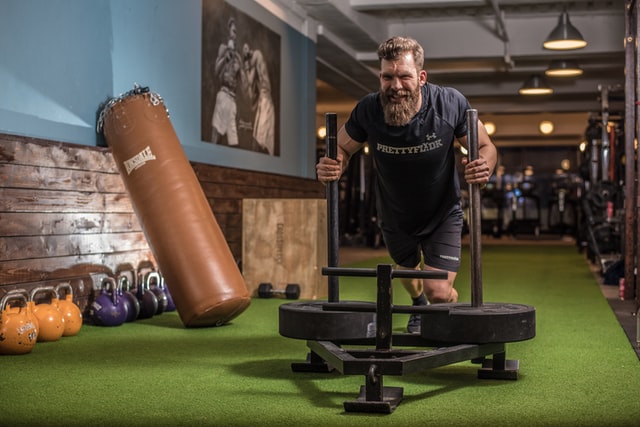When trying to reduce excess fat reserves, it is necessary to proceed with caution and prudence. It is not enough just to compile and follow a rational nutrition plan. We need to reduce weight reduction as well as the overall lifestyle adjustment. An equally important role as a careful selection of quality food in the right amount is also played by enough quality sleep and regular exercise of reasonable intensity . You will learn about how to set the movement mode very easily, but at the same time optimally and at the same time effectively. The article is intended primarily for obese clients (or their coaches) who want to make the most of their efforts and achieve satisfactory results.
What is the role of physical activity in weight reduction?
Physical activity plays a crucial role in weight reduction. At least as important as diet. However, just as we avoid any crazy dietary excesses that can harm a client’s health with a rationally determined diet , we should focus equally on setting up a training program . This can then be a tool to avoid stagnation of body weight and achieve the best results in the shortest possible time. However, in the opposite case, when we choose inappropriate exercises with undue load, the training plan becomes a broom that devastates the musculoskeletal system.
During caloric deficiency , which is crucial for weight reduction, there is a natural slowdown in metabolism . This is for the body to save energy and nutrients. It is, in fact, an adaptation mechanism that ensured the survival of our ancestors. The slowdown in metabolism is also accompanied by inconspicuous subconscious changes in motor behavior. For example, more often we lean on something, take a “weaker” attitude, sit more and so on. This saves the body a few calories for good. Not much, though enough to reduce the caloric deficit or even zero it completely. As a result, we eat less, we are more tired, we have less motivation, but we do not lose weight. An unequivocal reason to cough up everything and return to the original unhealthy composition of the menu, but because of which we get all the pounds back, and even a few more bonus pounds.

To prevent this stagnation and subsequent resignation, we must first improve the quality of sleep so that the body is rested for the next day and ready to burn calories. This is because in the case of a sleep deficit, the amount of energy expended during the day is demonstrably decreasing. Secondly, when we are relaxed and fresh enough, we have to move! Not 2 hours a week, but every 2 hours!
When you exercise, so meaningfully and safely!
The biggest mistake with far-reaching consequences is when obese clients are forced to move and exercise just to burn as many calories as they can at all costs. Such a movement not only lacks meaning and represents suffering rather than joy, but often this effort leads to the creation of training excesses , the aim of which is to literally destroy and exhaust the client . The consequences will show the very next day, when yesterday’s hard work becomes today’s lazar, which tries to avoid any painful movement and, paradoxically, rests even more than if it had not practiced at all. It is enough if such a person has an inappropriate training lesson twice a week. These two hours will provide less exercise for the rest of the week.

From a long-term perspective, we can expect both acute and chronic painful conditions, musculoskeletal injuries, faster joint degeneration and so on. At the peak of training excesses are group lessons, which, although they seem to be a good driving force thanks to support from social factors, do not completely respect the individuality of the exerciser and are, as a purely commercial tool, conducted completely unprofessionally. Although they represent a diverse range of “functional” exercises, which together lack any meaning. It’s like going to the supermarket and randomly choosing all sorts of ingredients from which we will bake a cake in the style of a dog and a cat.
Each exerciser deserves an individual approach. The situation with obese clients is more challenging because these people usually have no physical and exercise experience. They may even have it as a negative experience from school physical education classes, which brings these individuals more resistance often than a hobby in “physical culture”. Obesity also brings certain morphological changes in the musculoskeletal system and, of course, also represents more degenerative joint changes with age, which puts obese practitioners at a significant disadvantage .
Know that the goal of the training plan is always the same, ie a healthy and good-looking body with a confident mind. The only difference is the beginning. Therefore, it is counterproductive to randomly invent an exercise station and let an aged athlete and an obese person who came “only” to lose weight train on it.
How to move and how not?
The initial intensity, frequency and volume of physical activity vary according to experience, weight, individual structure, age, health status, personal preferences and the like. Everyday dynamic walking is a matter of course. If walking on the plane is too easy, do not start running right away, but rather go uphill. You can also use Nordic walking for a more comprehensive involvement of the whole body.

It doesn’t hurt anyone to go swimming a few times a month(The most suitable swimming style is a sign, but watch out for the head). In the summer months, if you have a swimming pool in the garden, water exercises or hydrokinesiotherapy are great. The water relieves the load-bearing joints, but at the same time represents resistance to movement in all directions. You can use, for example, simply moving your arms back and forth (alternately pre-armpit and roast) with as much effort as possible, or running in the water (if you have water in your waist). Rather than pedaling on an exercise bike, an elliptical trainer is a better choice. Of course, all these activities, which are necessary to do on a daily basis, must be performed at a reasonable load, which should be around 60% of the maximum heart rate. This is approximately a load during which you are able to communicate with others (but it does not mean that you should gossip).
If we move from the sphere of everyday aerobic activities towards resistance training, we will certainly not avoid “functional” training. Since “functional exercise” is not an official concept and everyone can grasp it at their own discretion and need, we will look at it from a different angle. For you – in an effort to build a healthy and handsome body while avoiding unnecessary loss of time, counterproductive behavior and health gambling – the good old classic in the form of a traditionally equipped gym is the most suitable at the moment .

You don’t need any nonsense in the form of vibrating and balancing platforms, but pulleys, dumbbells and a few machines will suffice. Initial training can consist of basic, complex exercises with an emphasis on the technique that needs to be constantly improved. It is therefore better to practice 3 basic exercises during training, consciously performed with precise technique, proper breathing (which is very important here) and in sufficient volume and load, than to alternate 20 stations, where the exercisers just knocked, twisted and swayed in confusion. Suitable exercises are specifically:
- pulling the upper pulley to the chest
- horizontal pulls on the machine or pulley (rowing on the pulley)
- alternating pressures of one arm above the head
- bench-press with single arms or horizontal pressures sitting on the machine
- Romanian deadlift
- legpress (or squats with a one-handed barbell for more advanced)
- burying on the machine
- calf extensions and toe lifting
And that would be all. Quite simple and straightforward, right? A training plan composed of these basic exercises (or variations according to individual needs) will ensure that the obese client, who is usually a complete beginner, masters the technique of basic exercises, supports energy expenditure, maintains healthy joints and ensures muscle shaping that will be ready to discover . Thanks to the fact that the training remains the same (we only gradually increase the volume and intensity), we avoid unwanted exercise pain and, on the contrary, we ensure a regular supply of endorphins, which will make the training a desirable addiction.
If the client does not manage to perform these exercises with the right technique or already suffers from some pain, it is necessary to choose more specialized procedures and solve specific problems . Particular attention in obese exercisers is required, for example, by the adjustment of the lower limbs, especially the knees, which tend to collapse inwards due to the flattening of the feet. Among other things, there is also an increased risk of injury to the ligaments of the knee or Achilles tendon. Unsuitable exercises for obese clients are, for example:
- run
- handles
- lunges
- passive stretching
- any jumping
- sitting beds and different types of tippers
- any exercise on balance mats or vibrating plates
- kettlebell swing
- prowler sled

Conclusion
We will now briefly summarize the information contained in this article on which obese clients and their trainers should be based:
- Exercise and exercise are as important in a reduction diet as diet and sleep.
- Obese clients should be considered as “disadvantaged beginners” and proceed accordingly when creating and maintaining a training plan.
- Training should not only lead to burning as many calories as possible or sweating clothes, and in no case should it aim to completely destroy the client .
- The goal of training is to increase caloric expenditure, but certainly not at the expense of health .
- The most sensible is the choice of easy, basic and complex exercises, arranged in a training plan 2 to 3 times a week, with gradual progress in the form of increasing the load and volume of training.
- Central is regular physical activity in the form of walking or swimming evenly distributed throughout the day.
- The main emphasis should be on exercise technique and regular breathing .
- In the case of pre-existing health problems or diseases of the musculoskeletal system, we choose specialized procedures from the relevant specialist.
At the end of the article, I would like to wish all hard workers, especially strong will and deserved results. Weight loss is basically very simple, but not fast or easy . It is especially important that you avoid not only dietary but also exercise excesses, which in the end will do more harm than good.

